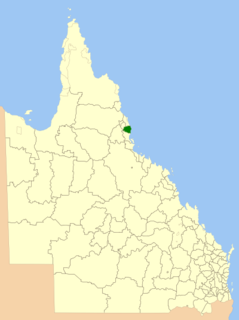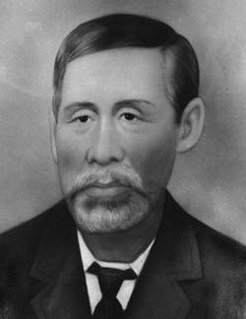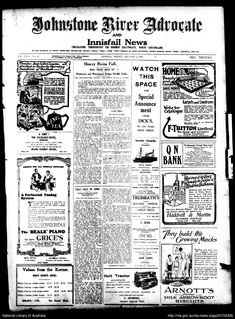
Innisfail is a town and locality in the Cassowary Coast Region in Far North Queensland, Australia. The town was originally called Geraldton until 1910. It is the major township of the Cassowary Coast Region and is well renowned for its sugar and banana industries, as well as for being one of Australia's wettest towns. In March 2006, Innisfail gained worldwide attention when severe Tropical Cyclone Larry passed over causing extensive damage. In the 2016 census, the town of Innisfail had a population of 7,236 people.

The North Coast railway line is a narrow gauge railway line in Queensland, Australia. It commences at Roma Street station, Brisbane, and largely parallels the Queensland coast to Cairns in Far North Queensland. The line is electrified between Brisbane and Rockhampton. Along the way, the 1680 km railway passes through the numerous towns and cities of eastern Queensland including Nambour, Bundaberg, Gladstone, Rockhampton, Mackay and Townsville. The line though the centre of Rockhampton runs down the middle of Denison Street.

The Shire of Mareeba is a local government area at the base of Cape York Peninsula in Far North Queensland, inland from Cairns. The shire, administered from the town of Mareeba, covered an area of 53,491 square kilometres (20,653.0 sq mi), and existed as a local government entity from 1879 until 2008, when it amalgamated with several councils in the Atherton Tableland area to become the Tablelands Region.

The Shire of Eacham was a local government area of Queensland. It was located on the Atherton Tableland, a plateau forming part of the Great Dividing Range west of the city of Cairns. The shire, administered from the town of Malanda, covered an area of 1,126.4 square kilometres (434.9 sq mi), and existed as a local government entity from 1910 until 2008, when it amalgamated with several other councils in the Tableland area to become the Tablelands Region.

The Shire of Johnstone was a local government area of Queensland. It was located on the Coral Sea coast about 90 kilometres (56 mi) south of the city of Cairns. The shire, administered from the town of Innisfail, covered an area of 1,639.1 square kilometres (632.9 sq mi), and existed as a local government entity from 1881 until 2008, when it amalgamated with the Shire of Cardwell to form the Cassowary Coast Region.

The Shire of Cardwell was a local government area of Queensland. It was located on the Coral Sea coast about halfway between the cities of Cairns and Townsville. The shire, administered from the town of Tully, covered an area of 3,062.2 square kilometres (1,182.3 sq mi), and existed as a local government entity from 1884 until 2008, when it amalgamated with the Shire of Johnstone to form the Cassowary Coast Region.

The Cassowary Coast Region is a local government area in the Far North Queensland region of Queensland, Australia, south of Cairns and centred on the towns of Innisfail, Cardwell and Tully. It was created in 2008 from a merger of the Shire of Cardwell and the Shire of Johnstone.

Innisfail Court House is a heritage-listed court house at 10 Edith Street, Innisfail, Cassowary Coast Region, Queensland, Australia. It is the town’s third court house. It was designed in the inter-war classical style by the Department of Public Works (Queensland) and built in 1939 by day labour. The current court house is a two-storeyed brick building with a corrugated-iron roof. It was added to the Queensland Heritage Register on 13 January 1995.

The Johnstone River, comprising the North Johnstone River and the South Johnstone River, is a river system located in Far North and North Queensland, Australia.

East Innisfail is a suburban locality in the Cassowary Coast Region, Queensland, Australia. In the 2016 census, East Innisfail had a population of 1,855 people.

Father Michael Martin Clancy OSA (1868–1931) was an Irish-Australian Roman Catholic priest. He was the first resident Parish Priest in Geraldton, a town and parish in North Queensland, Australia. He was an inspirational parish priest who developed the Parish, established Catholic education in the Johnstone River district and built Innisfail's present Mother of Good Counsel Church. He played an important part in the development in the town and the district. Father Clancy was enthusiastically involved in the life of the town, local committees and governing bodies. He was instrumental in the changing of Geraldton's name to Innisfail in 1910. He also advocated for forging a link to the Atherton Tableland and the use of Mourilyan Harbour by shipping. Mount Father Clancy Garreth McGonnell near the Beatrice River was named in his honour.
'Sugar Lighters in the Johnstone River, Queensland' In the early days of settlement at Geraldton [now Innisfail], the Johnstone River had a sand bar at the mouth and several shallow stretches in the river. This caused difficulties for shipping. Large ships had to either anchor at the mouth of the river and wait for a suitable high tide so that the bar could be crossed or anchor in Mourilyan Harbour to the south. The problem of large ships being unable to enter the river made it difficult for bags of sugar from the district sugar mills to be transported to southern refineries. To overcome this problem, shallow draft steam ships and lighters [often called sugar lighters] were used to carry the bags of sugar down the Johnstone and out to meet larger ships standing off the coast. or in nearby ports, mainly Cairns. These larger ships then transported the cargo to its destination. These small ships became known as "The Mosquito Fleet".

Tom See Poy, also known as Taam Sze-Pui, was a Chinese Australian storekeeper in Innisfail, Queensland, Australia. At its peak, his department store See Poy & Sons was one of the foremost department stores in north Queensland.
Cardstone is a rural locality in the Cassowary Coast Region in Queensland, Australia. It is 50 kilometres (31 mi) south-west of Innisfail.

Mourilyan Harbour is a coastal locality and harbour within the Cassowary Coast Region, Queensland, Australia. In the 2016 census, Mourilyan Harbour had a population of 156 people.

Patrick James Leahy was a journalist, and member of both the Queensland Legislative Council and the Queensland Legislative Assembly.

The Innisfail Advocate is a newspaper published in Innisfail, Queensland, Australia.

McCowat's Farm is a heritage-listed plantation at McCowat Road, Garradunga, Cassowary Coast Region, Queensland, Australia. It was built in 1920 by William Purdy. It is also known as Koodla. It was added to the Queensland Heritage Register on 21 October 1992.

Johnstone Shire Hall is a heritage-listed town hall at 70 Rankin Street, Innisfail, Cassowary Coast Region, Queensland, Australia. It was designed by Hill & Taylor and built from 1935 to 1938 by Van Leeuwen Brothers. It was added to the Queensland Heritage Register on 13 January 1995.

St Saviour's Anglican Church is a heritage-listed former church building at 26 Hynes Street, South Johnstone, Cassowary Coast Region, Queensland, Australia. It was built from 1938 to 1939 by Mose Romano. It was added to the Queensland Heritage Register on 24 September 2004.



















